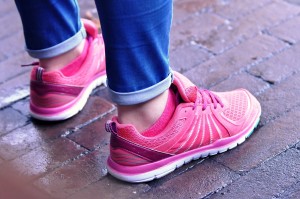Chi walking can strengthen your core, boost your endurance and improve your fitness levels. It’s easier on your body than traditional walking, and involves multiple muscle groups. And if you are a runner, Chi walking is a great way to help you trump your personal best running distance and time.
What is Chi Walking?
 Do you remember how you walked as a child? Watch children walking to get an idea of exactly what Chi walking is all about. When children walk, they tend to lean forward, allowing gravity to power them along.
Do you remember how you walked as a child? Watch children walking to get an idea of exactly what Chi walking is all about. When children walk, they tend to lean forward, allowing gravity to power them along.
Adults typically walk with their hips forward, propelling them along with their legs. This puts a lot of pressure on leg muscles, and if you walk long distances this way, injury and pain often accompany your jaunt.
Chi walking, just like any other form of walking, involves your legs. But you don’t have to rely on them for all of your power. Traditional walking means pushing off of your toes. This can lead to all kinds of injuries and soreness, from shin splints to sore calves and even plantar fasciitis. Chi walking, on the other hand, puts an emphasis on loose joints, good posture and engaging your core muscles.
You also mentally focus on relaxing your arms and legs. This minimizes the negative impact that walking has on your joints and limbs.
How to Chi Walk
#1: Begin by standing up straight, with your feet shoulder width apart. Your toes should be pointing directly forward. Imagine your body as straight as a ruler, perfectly vertical from your heels to your head.
Contract your lower abs, imagining your spine pulling your belly button towards it.
#2: Begin walking by slightly leaning forward. You want to lead with your upper body, so that you have to move your feet to keep yourself from falling over. Don’t tilt dramatically, just enough to move your shoulders forward over your hips.
Pump your arms and body only in the direction you are walking. You want to minimize side to side and up and down movement as much as possible.
Special Notes: You want to keep this forward tilt, while trying not to let your head dip. Your forearms and upper arms should make a 90 degree angle. Swing your arms backwards and forwards like a pendulum.
This creates propulsion power, along with the tilt of your body. Make sure your hands don’t go any further backwards than beside your body.
This is how Chi walking places less pressure on your legs to perform your walking motion. You also want to shorten your forward stride and lengthen your backward reach.
This is great for minimizing the strain on your knees, shins and caps. Try not to make the classic heel-to-toe step. Plant your feet firmly and flatly on the ground.
When you exhale, force air out of your mouth from your lungs, as if you are blowing out a candle on a birthday cake. Inhale through your nose, and keep your belly flat and compressed.
For your convenience, here is a video to demonstrate …
That’s all there is to Chi walking, a little-known core strengthening exercise that anyone can do, at any age or level of fitness.